Tangerine Tiger Shrimp (Caridina mariae) are an eye-catching freshwater shrimp species known for their vibrant orange color and striking tiger stripes. They are a popular choice among aquarists for their ability to add a splash of color and interesting behavior to an aquarium.
In this article, we will explore the various aspects of Tangerine Tiger Shrimp care, including their water parameters, temperature requirements, and the ease of keeping them in a home aquarium.
Difficulty Level of Keeping Caridina Shrimp
Tangerine Tiger Shrimp, like other Caridina species, can be slightly more challenging to keep than their Neocaridina counterparts. They require more specific water parameters and a well-established aquarium to thrive. However, with proper care and attention to water quality, even beginners can successfully keep these beautiful shrimp.
Size of Caridina mariae
Adult Tangerine Tiger Shrimp typically reach a size of 1-1.5 inches (2.5-3.8 cm) in length, making them a relatively small species suitable for nano and larger community aquariums. As with many other shrimp species, the size of Caridina mariae varies based on several factors, including age, diet, and water conditions.
Growth Stages of Tangerine Tiger
Tangerine Tiger Shrimp have several growth stages throughout their development, starting as tiny shrimp and growing into adults. The molting process, during which they shed their exoskeletons, allows them to grow.
Young shrimp will molt more frequently as they grow and develop. As they reach adulthood, molting slows down and becomes less frequent. It is essential to provide a balanced diet and adequate calcium to support healthy molting and growth.
Sexual Dimorphism
There is a noticeable size difference between male and female Tangerine Tiger Shrimp. Generally, females are larger and more robust than their male counterparts. Female shrimp can grow up to 1.5 inches (3.8 cm) in length, while males usually reach about 1 inch (2.5 cm).
In addition to size, female Tangerine Tigers also exhibit more intense coloration and patterns, making them more visually appealing to many hobbyists. This sexual dimorphism is an adaptation that allows females to carry and protect eggs during the breeding process.
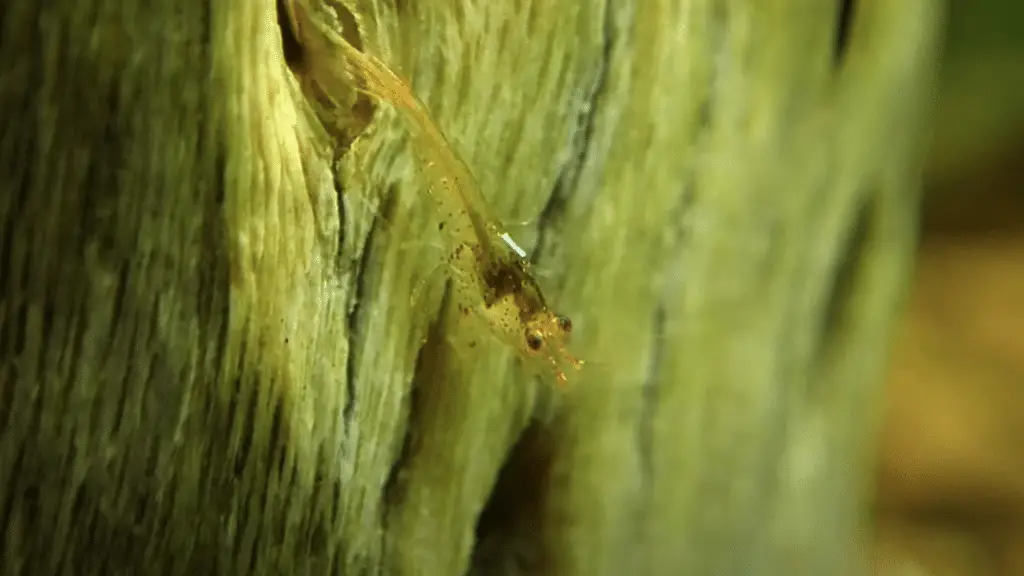
Tigers Shrimp Food
In the wild, tiger shrimp feed on a variety of small organisms, including algae, biofilm, and small invertebrates. In captivity, they can be fed a combination of commercially available shrimp foods and fresh or frozen foods.
Some popular commercial shrimp foods include shrimp pellets, shrimp sticks, and shrimp granules. These foods are formulated to provide the essential nutrients that shrimp need to thrive, such as protein, vitamins, and minerals.
It’s important to choose a high-quality shrimp food that is specifically designed for freshwater shrimp species.
Fresh or frozen foods that can be fed to tangerine tiger shrimp include blanched vegetables such as spinach, zucchini, and carrots, as well as small pieces of fish, shrimp, or other seafood. It’s important to ensure that any food provided is clean and free of contaminants.
In addition to providing a varied diet, it’s important to avoid overfeeding tangerine tiger shrimp. Overfeeding can lead to poor water quality, which can be harmful to the health of the shrimp and other aquarium inhabitants.
As a general rule, only feed as much as the shrimp can consume in 2-3 hours and remove any uneaten food after that time.
Overall, providing a balanced and varied diet is key to keeping tangerine tiger shrimp healthy and thriving in the aquarium.
Water Parameters for Tangerine Tiger Shrimp
Maintaining optimal water conditions is crucial for the health and longevity of Tangerine Tiger Shrimp. They require soft, slightly acidic water with the following parameters:
- Temperature: 68-75°F (20-24°C)
- pH: 6.0-6.8
- GH (General Hardness): 4-6 dGH
- KH (Carbonate Hardness): 1-3 dKH
It is essential to monitor these parameters consistently and ensure that the water conditions remain stable.
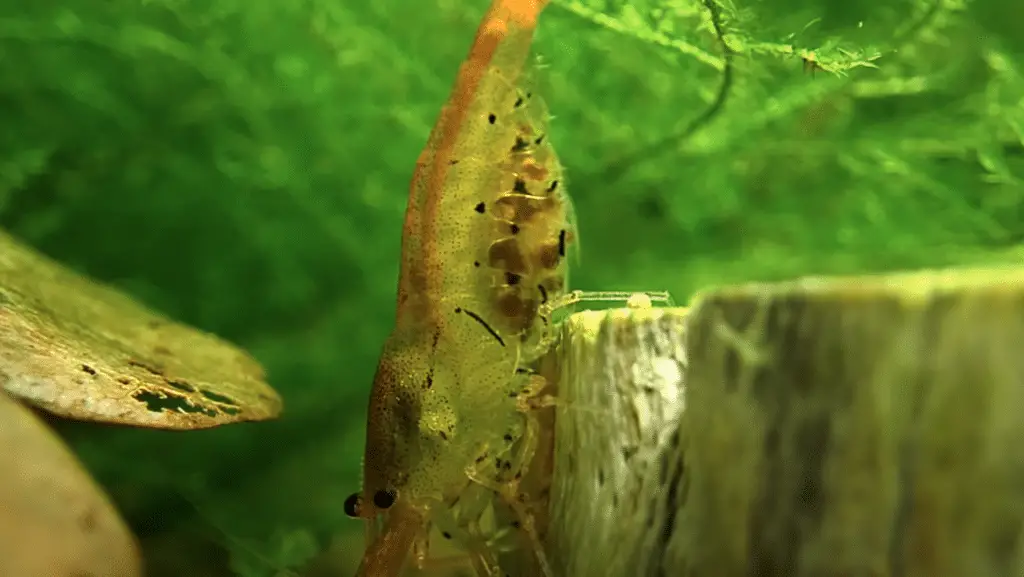
Varieties of Caridina mariae
Caridina mariae is a diverse species that includes several distinct varieties, each exhibiting unique colors and patterns. While the Tangerine Tiger Shrimp is a popular color variation, there are other equally fascinating and visually striking varieties that aquarists may consider.
In this section, we will delve deeper into some of the most well-known Caridina mariae varieties.
Black Tiger Shrimp
Black Tiger Shrimp display a dark base color, ranging from deep brown to black, adorned with thin, light-colored stripes reminiscent of a tiger’s coat. This striking contrast creates a bold, dramatic appearance that makes them a standout addition to any aquarium.
Like other Caridina varieties, Black Tiger Shrimp require specific water parameters and a well-established aquarium to thrive.
Blue Tiger Shrimp
Blue Tiger Shrimp are an attractive variety characterized by their deep blue base color and contrasting orange eyes. Their unique appearance makes them a highly sought-after shrimp for aquarists.
The intensity of the blue color can vary between individuals, and some specimens may even exhibit faint tiger stripes on their bodies. As with other Caridina, Blue Tiger Shrimp require a stable environment with specific water parameters to thrive.
Super Tiger Shrimp
Super Tiger Shrimp are a stunning variety known for their elongated bodies and distinct, bold striping. Their base color can range from translucent to light brown, with prominent, dark tiger stripes running the length of their bodies.
Their unique appearance and elongated body shape make them an appealing option for hobbyists seeking a more exotic look in their aquariums. Super Tiger Shrimp share similar water parameter requirements with other Caridina mariae varieties.
Orange Eye Blue Tiger Shrimp
A variation of the Blue Tiger Shrimp, the Orange Eye Blue Tiger Shrimp boasts a deep blue base color with bright, orange eyes that make them stand out in any aquarium setting.
These shrimp are highly sought after for their vivid coloration and intriguing appearance. They require similar care and attention to water parameters as other Caridina mariae varieties.
Each Caridina variety offers its unique visual appeal, making them fascinating additions to a shrimp enthusiast’s aquarium. Whether you prefer the vibrant orange hues of the Tangerine Tiger, the dramatic contrast of the Black Tiger, the deep blue tones of the Blue Tiger, or the exotic appearance of the Super Tiger, there is a Caridina variety to suit every taste.
By providing the appropriate water conditions and a suitable environment, you can successfully keep and enjoy these captivating invertebrates in your aquarium.

Preferred Water Conditions for Caridina Shrimp
While their ideal parameters are soft, slightly acidic water, they have been successfully bred in both soft and hard water environments, indicating their versatility.
In this section, we will discuss the preferred water conditions for Caridina shrimp and their adaptability to various environments, including Neocaridina-friendly conditions.
Ideal Water Conditions:
As previously mentioned, the ideal water conditions for Tangerine Tiger Shrimp and other Caridina mariae varieties are as follows:
- Temperature: 68-75°F (20-24°C)
- pH: 6.0-6.8
- GH (General Hardness): 4-6 dGH
- KH (Carbonate Hardness): 1-3 dKH
These parameters provide a stable and comfortable environment for Tangerine Tiger Shrimp, promoting their health and longevity.
Adaptability to Neocaridina-Friendly Conditions
Tangerine Tiger Shrimp have proven to be more adaptable than some other Caridina species, and they can successfully be kept in Neocaridina-friendly water conditions.
This adaptability makes them an easier option for hobbyists who may not have the means to maintain the more specific water parameters required by other Caridina species.
The typical Neocaridina water parameters are
- Temperature: 65-85°F (18-29°C)
- pH: 6.5-8.0
- GH: 4-12 dGH
- KH: 3-15 dKH
Although Tangerine Tiger Shrimp can survive and even thrive in these conditions, it is essential to note that more significant deviations from their ideal parameters might impact their health, coloration, and breeding success.
Maintaining a Stable Environment:
Regardless of the specific water parameters, maintaining a stable and consistent environment is crucial for the wellbeing of Tangerine Tiger Shrimp. Rapid fluctuations in temperature, pH, or hardness can stress the shrimp, leading to health issues and potentially decreased lifespan.
It is essential to monitor water conditions regularly and address any changes that may occur promptly.
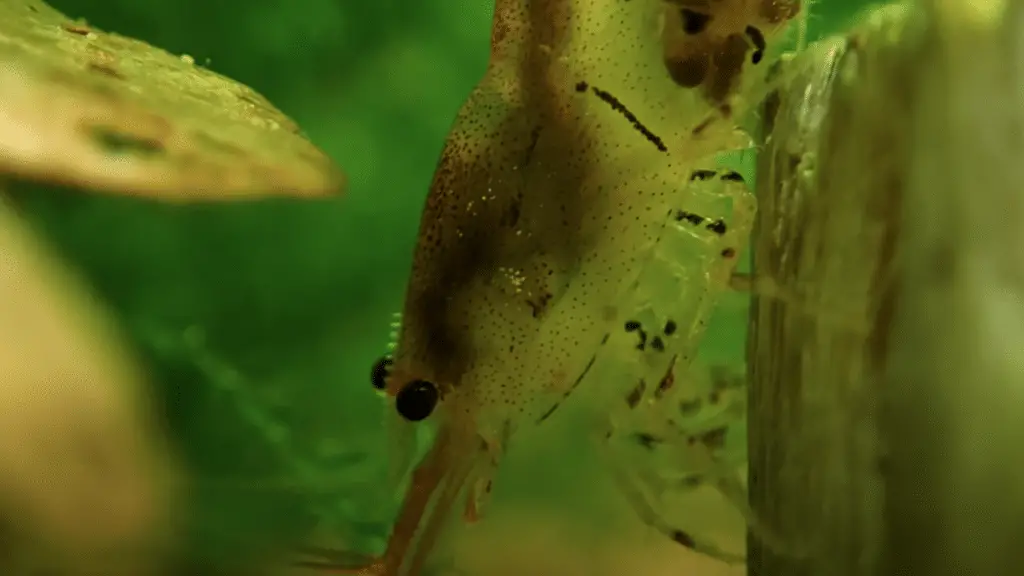
Difficulty Level of Keeping Tiger Shrimp
Tiger shrimp, including the Tangerine Tiger variety, have a reputation for being slightly more challenging to keep than other shrimp species due to their specific water parameter requirements.
However, as we have discussed earlier, these shrimp have shown adaptability to a range of environments, making them easier to keep and breed than one might initially assume.
In this section, we will explore the factors contributing to the ease of keeping and breeding tiger shrimp, along with essential tips for success.
Adaptable Nature:
As previously mentioned, Tangerine Tiger Shrimp and other Caridina mariae varieties can adapt to a wide range of water conditions, including those typically associated with Neocaridina species.
This adaptability allows hobbyists to keep and breed these shrimp without the need for highly specialized water parameters, making them more accessible to beginners and experienced aquarists alike.
Breeding Ease
Tangerine Tiger Shrimp are relatively prolific breeders when provided with the right conditions. As long as they are housed in a stable environment with suitable water parameters, they will readily breed and produce offspring.
A well-established, planted aquarium with plenty of hiding spots and a balanced diet will encourage breeding behavior and provide a safe environment for the larvae to grow and develop. Their ease of breeding makes them an appealing choice for those interested in populating their aquarium with these stunning invertebrates.
Tips for Keeping and Breeding Tiger Shrimp
To ensure the health and wellbeing of your Tangerine Tiger Shrimp and to encourage breeding, consider the following tips:
- Maintain stable water conditions: While Tangerine Tigers can adapt to a range of water parameters, maintaining stability is crucial for their health and breeding success.
- Provide a suitable environment: A well-planted aquarium with ample hiding spots will help reduce stress and promote breeding behavior.
- Offer a balanced diet: Feeding your shrimp a varied diet, including high-quality shrimp pellets, blanched vegetables, and supplemental sources of calcium, will support their health and reproductive success.
- Practice proper tank maintenance: Regular water changes, substrate cleaning, and equipment maintenance will contribute to a healthy environment for your shrimp.
In conclusion, while Tangerine Tiger Shrimp and other Caridina varieties may have a reputation for being more challenging to keep, their adaptable nature and ease of breeding make them more accessible than one might initially assume.
By providing a stable environment, a suitable habitat, and a balanced diet, hobbyists of all experience levels can successfully keep and breed these beautiful shrimp.
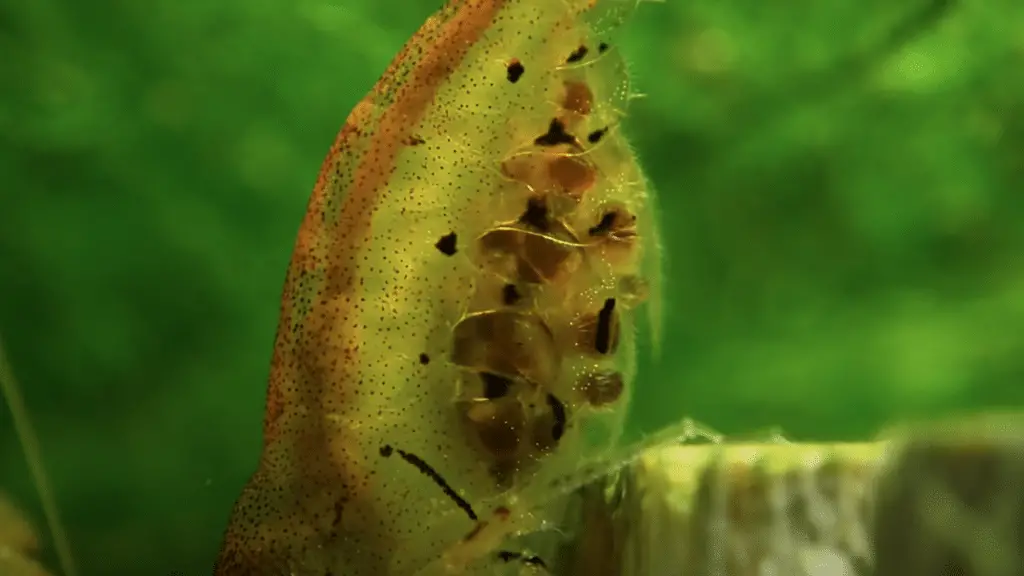
Crossbreeding Potential of Caridina Shrimp: An Intriguing Genetic Exchange
Caridina shrimp, such as Tangerine Tigers, exhibit an interesting characteristic: they have the potential to crossbreed with other types of shrimp, including Crystal Reds, Crystal Blacks, and Taiwan Bee shrimp. This crossbreeding can result in unique and visually striking offspring, making Caridina mariae shrimp even more appealing to hobbyists and breeders.
In this section, we will explore the crossbreeding potential of Caridina serrata shrimp and the implications it has for shrimp enthusiasts.
Crossbreeding between Tangerine Tigers and other Caridina species can lead to offspring with new and exciting color patterns and genetic traits. However, it is essential to note that crossbreeding may also result in less desirable traits or diminished coloration in some instances.
Therefore, breeders should carefully consider their goals and objectives before intentionally crossing different shrimp varieties.
For hobbyists interested in creating unique shrimp lines or discovering new color patterns, this crossbreeding potential can be an exciting aspect of keeping Caridina shrimp.
Additionally, the offspring of these crosses may exhibit increased hardiness and adaptability to a broader range of water conditions, depending on the specific shrimp varieties involved.
It is worth noting that, while crossbreeding can produce fascinating results, it may not be suitable for every hobbyist or breeder. Those who wish to maintain the purity of specific shrimp lines or focus on breeding shrimp with particular traits should avoid crossbreeding and instead concentrate on selective breeding within the same shrimp variety.
The Lifespan and Time to Maturity for Tangerine Tiger Shrimp: Understanding Growth and Longevity
Understanding their lifespan and maturity is essential for providing proper care and promoting a thriving, healthy population in your aquarium. In this section, we will explore the average lifespan of Tangerine Tiger Shrimp, the factors that influence their longevity, and the time it takes for these shrimp to reach maturity.
The lifespan of Tangerine Tiger Shrimp
The average lifespan of Tangerine Tiger Shrimp is 1-3 years under optimal conditions. However, their longevity can be influenced by various factors, including water conditions, diet, stress, and overall health. To ensure a long and healthy life for your shrimp, it is crucial to maintain stable water parameters, provide a balanced diet, and address any potential stressors in their environment.
Factors Influencing Longevity:
- Water conditions: As previously discussed, Tangerine Tiger Shrimp can adapt to a range of water parameters, but maintaining stable and ideal conditions is essential for their wellbeing and lifespan. Rapid fluctuations in temperature, pH, or hardness can stress the shrimp, leading to health issues and potentially decreased lifespan.
- Diet: A balanced diet rich in essential nutrients is critical for supporting the health and longevity of Tangerine Tiger Shrimp. Providing high-quality shrimp pellets, blanched vegetables, and supplemental sources of calcium will ensure their dietary needs are met.
- Stress: Minimizing stressors in the aquarium, such as aggressive tank mates or a lack of hiding spots, will contribute to the overall wellbeing and lifespan of your shrimp.
- Overall health: Monitoring your shrimp for signs of illness or disease and taking prompt action to address any health concerns is essential for maintaining a healthy population and maximizing their lifespan.
Time to Maturity for Tiger Shrimp
Tangerine Tiger Shrimp generally reach maturity between 3-4 months of age, at which point they can breed. Their growth rate can be influenced by water conditions, diet, and overall health.
Providing a stable environment, a balanced diet, and proper care will support their growth and ensure they reach maturity in a timely manner.
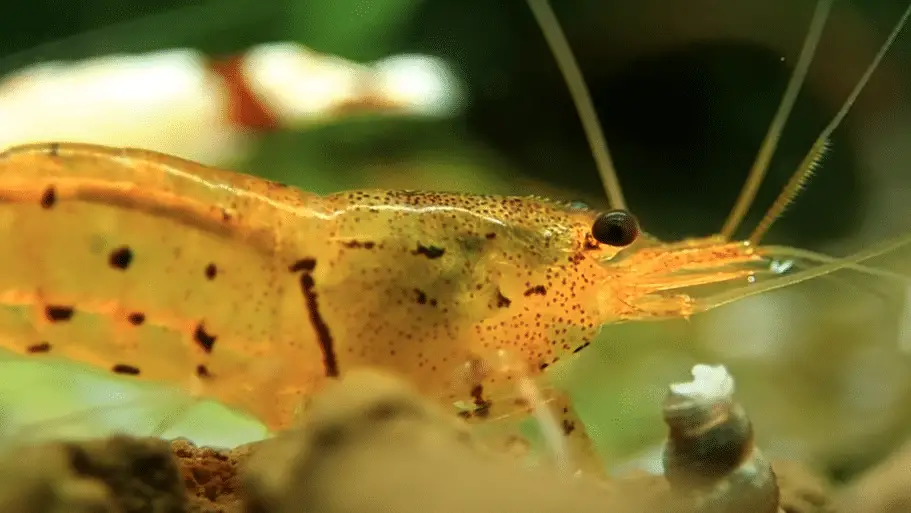
Conclusion
Tangerine Tiger Shrimp are an attractive and adaptable addition to any peaceful freshwater aquarium, suitable for both beginner and experienced aquarists. Their vibrant coloration and engaging behavior make them a popular choice among shrimp enthusiasts.
When provided with proper care, Tangerine Tiger Shrimp can thrive in a range of water conditions, including those typically associated with Neocaridina species. Their ability to adapt to various environments and breed readily contributes to their appeal and accessibility.
However, maintaining stable water parameters, providing a balanced diet, and offering a suitable habitat are essential for ensuring their health, longevity, and reproductive success.
With a typical size of 1-1.5 inches (2.5-3.8 cm), Tangerine Tigers, as well as other Caridina mariae varieties, exhibit sexual dimorphism and undergo several growth stages. They generally reach maturity at around 3-4 months of age and have an average lifespan of 1-3 years.
By closely monitoring their health and addressing any potential issues, you can create a thriving, healthy environment for these captivating invertebrates.
As part of the diverse Caridina mariae species, Tangerine Tiger Shrimp share the spotlight with other striking varieties such as Black Tiger, Blue Tiger, Super Tiger, and Orange Eye Blue Tiger Shrimp.
These shrimp offer a wide range of visual appeal and fascinating behaviors, making them a valuable addition to any shrimp enthusiast’s collection.
In conclusion, by understanding the unique characteristics and requirements of Tangerine Tiger Shrimp, you can successfully keep and breed these beautiful creatures, enjoying their stunning appearance and fascinating behavior for years to come.
FAQ Section: Tangerine Tiger Shrimp
Q: How hard are Caridina shrimp to keep? A: Tangerine Tiger Shrimp, a variety of Caridina shrimp, are relatively easy to keep and breed, thanks to their adaptability to a range of water conditions.
However, maintaining stable water parameters, providing a balanced diet, and offering a suitable habitat are essential for ensuring their health and wellbeing.
Q: What is the size of Caridina mariae? A: Tangerine Tiger Shrimp, a variety of Caridina mariae, typically grow to a size of 1-1.5 inches (2.5-3.8 cm).
Q: What water parameters do Tangerine Tiger Shrimp need? A: Ideally, Tangerine Tiger Shrimp prefer soft, slightly acidic water with the following parameters: temperature of 68-75°F (20-24°C), pH of 6.0-6.8, GH of 4-6 dGH, and KH of 1-3 dKH.
However, they are adaptable and can also thrive in Neocaridina-friendly water conditions.
Q: What varieties do Caridina mariae come in? A: Caridina mariae includes several distinct varieties, such as Tangerine Tiger, Black Tiger, Blue Tiger, Super Tiger, and Orange Eye Blue Tiger Shrimp. Each variety offers unique colors and patterns.
Q: What temp do Tangerine Tiger Shrimp need to be? A: Tangerine Tiger Shrimp prefer a water temperature of 68-75°F (20-24°C).
Q: Are Tiger Shrimp hard to keep? A: While Tiger Shrimp, including Tangerine Tigers, may have a reputation for being more challenging to keep due to their specific water parameter requirements, their adaptable nature and ease of breeding make them more accessible than one might initially assume.
Q: How long do Tangerine Tiger Shrimp live? A: The average lifespan of Tangerine Tiger Shrimp is 1-3 years under optimal conditions.
Q: How long does it take for Tiger Shrimp to mature? A: Tangerine Tiger Shrimp generally reach maturity between 3-4 months of age, at which point they are capable of breeding.
